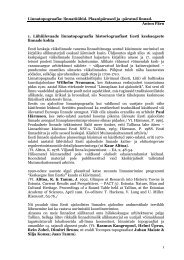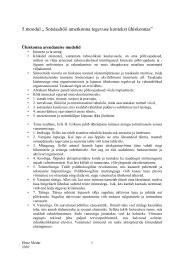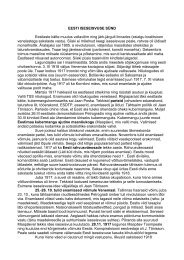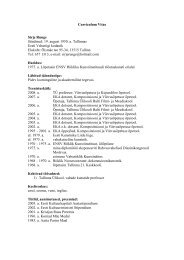crowding and children's mental health: the role of house type
crowding and children's mental health: the role of house type
crowding and children's mental health: the role of house type
Create successful ePaper yourself
Turn your PDF publications into a flip-book with our unique Google optimized e-Paper software.
222 G. W. Evans et al.<br />
dwellings, might exacerbate negative impacts <strong>of</strong> residential<strong>crowding</strong><br />
on children’s psychologicalwell<br />
being.<br />
One <strong>of</strong> <strong>the</strong> major underlying psychological processes<br />
that appears to account for some <strong>of</strong> <strong>the</strong> negative<br />
e¡ects <strong>of</strong> <strong>crowding</strong> is loss <strong>of</strong> control over<br />
interpersonalinteraction (Altman, 1975; Saegert,<br />
1982). Too much unwanted socialinteraction is a frequent<br />
concommitent <strong>of</strong> <strong>crowding</strong> (Baum & Valins,<br />
1977, 1979; Mc Carthy & Saegert, 1979). When interior<br />
spaces are designed to foster better regulation <strong>of</strong><br />
interpersonalcontact, residentialdensity seems to<br />
have less negative impact. Baum <strong>and</strong> colleagues in<br />
a series <strong>of</strong> studies have shown that long corridor<br />
dormitory designs in comparison to ei<strong>the</strong>r suites or<br />
short corridor designs caused elevated <strong>crowding</strong><br />
<strong>and</strong> greater problems with <strong>the</strong> regulation <strong>of</strong> social<br />
interaction (Baum & Valins, 1977, 1979). Follow-up<br />
research revealed that when longer corridor dormitories<br />
were redesigned so that <strong>the</strong> number <strong>of</strong> residents<br />
sharing a common corridor was reduced, <strong>the</strong><br />
negative <strong>crowding</strong> e¡ects were attenuated (Baum &<br />
Davis, 1980). It is important to note that <strong>the</strong> students<br />
in Baum’s studies did not choose <strong>the</strong>ir housing<br />
accomodations. Cox et al. (1982) <strong>and</strong> Schae¡er et al.<br />
(1988) found that redesigning prison sleeping areas<br />
to enable better regulation <strong>of</strong> social interaction reduced<br />
<strong>crowding</strong>, improved physical<strong>health</strong>, <strong>and</strong> lowered<br />
both psychophysiological <strong>and</strong> self-reported<br />
stress. Floorplan con¢gurations that a¡ord greater<br />
opportunity for being alone also attenuate <strong>the</strong> negative<br />
impacts <strong>of</strong> residentialdensity on psychological<br />
well being. Evans et al. (1996) used spatialsyntax<br />
analysis to quantify residential £oorplans among<br />
o¡ campus student housing units. Floorplans with<br />
greater depth bu¡ered <strong>the</strong> <strong>crowding</strong>^distress relationship.<br />
Depth is a measure <strong>of</strong> <strong>the</strong> degree <strong>of</strong> separation<br />
between di¡erent spaces within a<br />
£oorplan con¢guration <strong>and</strong> predicts social interaction<br />
(Hillier & Hanson, 1984).<br />
Residentialdesign can also make a di¡erence in<br />
how children respond to <strong>crowding</strong>. Wachs <strong>and</strong><br />
Gruen (1982) found that preschoolchildren in more<br />
crowded homes manifested delayed cognitive development.<br />
Both cross-sectional<strong>and</strong> longitudinalevidence<br />
re£ected this trend. Interestingly if <strong>the</strong>se<br />
children had access to a room where <strong>the</strong>y could<br />
spend time alone, <strong>the</strong> negative develop<strong>mental</strong> correlates<br />
<strong>of</strong> residential <strong>crowding</strong> were diminished.<br />
There is also evidence that when children live in<br />
larger, multiple family dwelling complexes, emotional<br />
well being may be a¡ected. Children living<br />
in high-rise, multiple dwelling complexes have higher<br />
rates <strong>of</strong> behavioralproblems in comparison to<br />
those residing in single-family homes or smaller,<br />
low-rise buildings (Ineichen & Hooper, 1974; Richman,<br />
1977; Saegert, 1982). Rates <strong>of</strong> juvenile delinquency<br />
are also higher among adolescents in<br />
multiple dwelling units relative to those in single-family<br />
detached homes (Gillis, 1974). Of particular relevance<br />
to <strong>the</strong> present study, <strong>the</strong> major hypo<strong>the</strong>sis<br />
o¡erred to account for <strong>the</strong> apparent covariation between<br />
housing <strong>type</strong> <strong>and</strong> children’s psychological distress<br />
is <strong>the</strong> relative inaccessibility to playspaces<br />
externalto <strong>the</strong> residence. This in turn is believed<br />
to lead to young children being cooped up inside<br />
with more intra-family con£ict <strong>and</strong> greater social<br />
isolation from peers (Halpern, 1995; Evans et al., in<br />
press; Gi¡ord, in press).<br />
In <strong>the</strong> present study, we were able to take advantage<br />
<strong>of</strong> an epidemiological study on environ<strong>mental</strong><br />
quality <strong>and</strong> children’s well being conducted in small<br />
towns <strong>and</strong> ruralareas in <strong>the</strong> Nor<strong>the</strong>rn TirolRegion<br />
<strong>of</strong> Austria, proximate to Innsbruck. Included in <strong>the</strong><br />
study protocolwere measures <strong>of</strong> residentialdensity<br />
(people per room), housing <strong>type</strong> (single-family, row<br />
<strong>house</strong>, multiple dwelling unit) <strong>and</strong> two indices <strong>of</strong><br />
<strong>mental</strong><strong>health</strong>. Based upon prior research on <strong>crowding</strong><br />
<strong>and</strong> architecture as well as on housing, we hypo<strong>the</strong>sized<br />
that elementary school children living<br />
in high-density homes in multiple dwelling complexes<br />
would su¡er greater psychological distress<br />
than those living in crowded homes that were ei<strong>the</strong>r<br />
single-family detached or row <strong>house</strong>s. Thus, we predicted<br />
an interaction between density <strong>and</strong> <strong>house</strong><br />
<strong>type</strong> on <strong>mental</strong><strong>health</strong>. Ano<strong>the</strong>r facet <strong>of</strong> this study<br />
warrants brief comment. Unlike previous psychologicalstudies<br />
<strong>of</strong> <strong>crowding</strong>, <strong>the</strong> data set is large, consisting<br />
<strong>of</strong> nearly 1300 children. This also enabled us<br />
to generate a dose^response function, examining<br />
variability in <strong>mental</strong> <strong>health</strong> over a range <strong>of</strong> residentialdensities<br />
typicalfor this region <strong>of</strong> Austria <strong>and</strong><br />
probably for much <strong>of</strong> non-urban, Western European.<br />
To our knowledge, no dose^response data currently<br />
exist on residentialdensity <strong>and</strong> <strong>mental</strong><strong>health</strong>.<br />
Participants<br />
Method<br />
One thous<strong>and</strong> two hundred <strong>and</strong> eighty children in<br />
grades 3^4 (M=9?44 years) were recruited by letters<br />
sent to families living in <strong>the</strong> Inn Valley <strong>of</strong> Tyrol in<br />
Austria. This age group was chosen to correspond to<br />
severalo<strong>the</strong>r studies <strong>of</strong> environ<strong>mental</strong>quality <strong>and</strong><br />
children’s <strong>health</strong> (Wohlwill & Heft, 1987; Evans et<br />
al., 1991; Evans, 2000). The response rate was 79.5%.


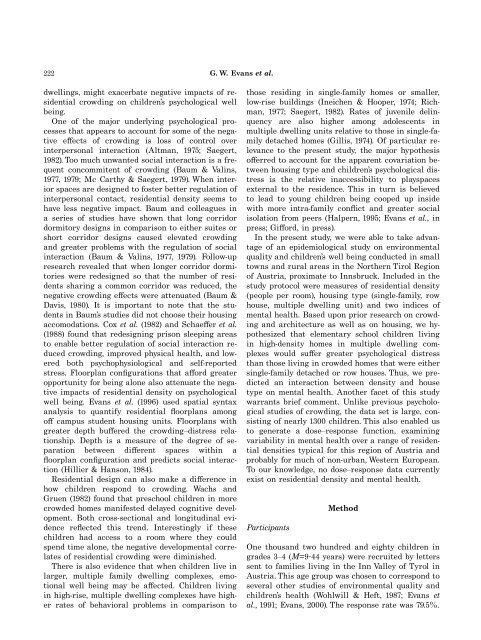
![5 Verben 2 S[1]. 35-44.pdf](https://img.yumpu.com/27096544/1/184x260/5-verben-2-s1-35-44pdf.jpg?quality=85)

